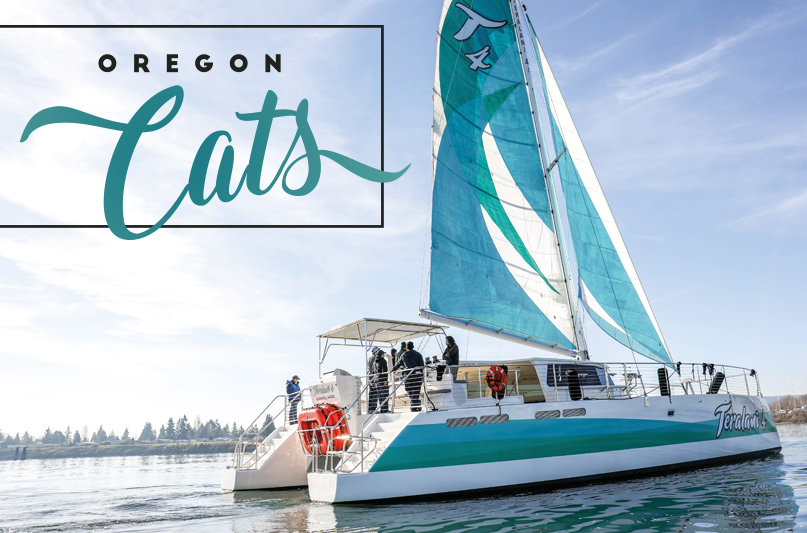
 Schooner Creek Boat Works has been a fixture in the Portland sailing scene since 1977, when Steve Rander opened the doors of a small shop beside the Columbia River’s South Channel next to the I-5 freeway. A lot of water has flowed under the I-5 bridge while Schooner Creek built a reputation with a series of wood-composite race boats 40’ to 75’ long that raced all over the Pacific. Today the yard is housed in a large airy building on Hayden Island with a repair yard and long-term storage covering six acres.
Schooner Creek Boat Works has been a fixture in the Portland sailing scene since 1977, when Steve Rander opened the doors of a small shop beside the Columbia River’s South Channel next to the I-5 freeway. A lot of water has flowed under the I-5 bridge while Schooner Creek built a reputation with a series of wood-composite race boats 40’ to 75’ long that raced all over the Pacific. Today the yard is housed in a large airy building on Hayden Island with a repair yard and long-term storage covering six acres.
They’ve come a long way from the early wooden boat days, but in terms of new construction, you could say they returned to their roots in the last few years. In the beginning, it was very much a wooden boat shop doing restorations and repairs with the new Gougeon epoxy method. Rander chose a traditional 20’ daysailer design by Bill Garden as the shop’s standard new build, and the small crew cold-moulded these Eel yawls out of cedar veneers on a semi-production basis, turning out one or two varnished hulls a year.
Then they built the 42’ Magic Carpet in 1982 in that small shop space using the same double-diagonal laminating pattern they had for the Eel, but they went “high tech” (for that era) by inserting a layer of structural foam between the inner and outer skins. Rander skippered the boat in several Pacific Cup races to Hawaii over the next decade. It is still sailing in the Pacific Northwest and is as stiff today as it was then.
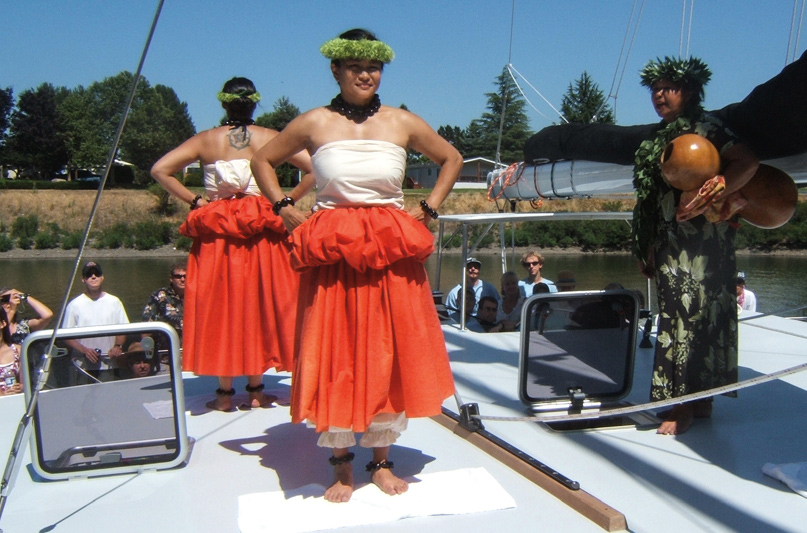
Above: Alii Nui, a Kurt Hughes 65′, is blessed by Hawaiian dancers in Canoe Bay on Hayden Island in 2010. She sails from Maui to this day.
Today, they have a standard hull mold once again and are working on one to two boats a year. Only now, those boats have twin 65’ hulls, can carry 49 passengers, and are as wide as a tennis court. The new builds have something else in common with their historic production of offshore keelboats—their recent launches have also sailed to Hawaii, not in a race, but on delivery to their homeports in the islands.
While you are unlikely to see a Schooner Creek charter catamaran in Puget Sound any time soon, all you have to do is book a trip to Hawaii and you will be in catamaran country!
What’s more, you can sail on any of these modern designs for the price of a ticket. Along with some of the best sailing in the world, they will take you to some pristine spots where you can snorkel above the coral and encounter truly amazing sea creatures. That’s what I did on the first of Schooner Creek Boat Works’ Hawaiian catamarans in 1998. The boat was the 36’ by 22’ Kamanu—an early Kurt Hughes design built in the 1980s. I recall there was just enough room in the old shop for the “cylinder” mold where the hulls were formed from multiple layers of marine plywood and epoxy.
I had a personal connection with that project because Hughes’ introduction to Schooner Creek Boat Works came when I invited him to Portland to give a talk at the local multihull club. (Yes, cruising multihulls really were all homebuilt in those distant times, and owners needed all the support they could get.) When the build got going, I was recruited to give a hand for the hull laminating, so I put on a plastic apron and gloves, and happily helped to position the sticky sheets on the mold.
That first catamaran was sized to fit a 40’ shipping container—that’s how it “sailed” to Hawaii. Some of the shop crew flew out to assemble it in the sun and had a great working vacation. I took a trip to the Big Island myself in 1998 and rode and dived off the Kamanu on the Kona coast. I wrote about the trip for Northwest Yachting in 1999—and the boat is still going strong today after another twenty years of daily cruises.
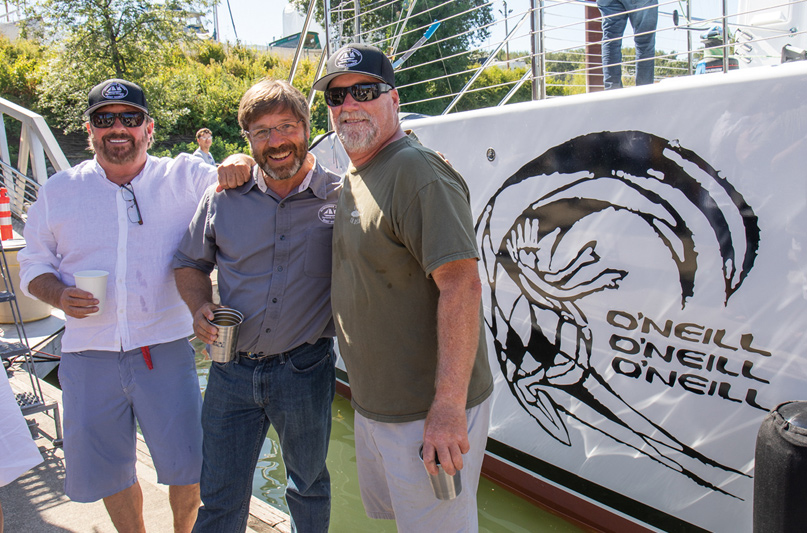
So how did that modest little boat shop come to its present position as the leading builder of high-tech, U.S. Coast Guard-certified sailing catamarans on the West Coast? Rander’s craftsmanship and skill as an offshore sailor certainly helped, but it was his willingness to adopt new technology and design concepts that really gave Schooner Creek Boat Works an edge over its competitors. From the mold for a 100’ Christensen megayacht to a vacuum-bagged ultra-light, Rander never met a design boat he couldn’t turn into reality at a fair cost for the customer.
He insisted that every boat be fitted out as if it was his own boat setting off across the Columbia Bar and onto the wide Pacific.
As the reputation of Rander’s work grew, the shop also expanded. The first move in the 1980s was into somewhat bigger premises on the other side of the freeway, though the space was definitely not big enough to handle the 70’ ultra-light yacht that Rander had always dreamed of owning. In the early 1990s, he dealt with that by adding a portable extension to the big doorway.
The 70’ Rage was designed by the Bay Area’s Tom Wylie and launched in 1993 with 13′ beam, 13’ draft, 21,000-pound displacement in racing trim with 10,000 pounds of it in the keel.
Rage was conceived to break records off the West Coast in style and raced regularly in the Pacific Cup or Transpac, where it proved that a long, light boat built in fairly high-tech wood and foam core could be affordable and still break records in the right conditions. In her first West Marine Pacific Cup, Rander knocked seven hours off the 1986 record set by Bill Lee’s legendary sled Merlin. In 1998, Rage had her fastest trip to Hawaii at an amazing 6 days and 19 hours for the 2,070 miles. The boat also appears to hold the obscure title of the biggest racing boat ever to sport a tiller.
Wylie partnered with Rander on a second long, slender racer, the 77′ Jelik, built with an unusual full-length wooden box girder on the centerline. It won the China Sea Race for its owner Frank Pong. The third member of this elite group was the Open 60 Ocean Planet for Bruce Schwab—a Californian sailor with the dream of breaking into the solo professional sailing circuit.
The unique Wylie long-distance design of the Ocean Planet was built in Schooner Creek Boat Works’ new premises on Hayden Island, another move for the company. Under a rental agreement with the property’s owner, local sailor Kevin Flanigan, began working with Rander and developed the property to accommodate the growing business (most notably adding the pilings, and ways and docks for the Travelift).
Flanigan was impressed by the 60-footer with its narrow beam, a fixed keel, and seawater ballast-tanks. Schwab did not find a title sponsor for Ocean Planet, but was able to complete the boat with companies donating their own brand of materials and equipment, and with some private sponsorship from Flanigan, who named the boat, giving the campaign a greater awareness of ocean ecology.
There have been other narrow Open 60s, but this is the only boat ever to successfully race through the stormy Southern Ocean without shrouds—twice. The rig was a lofty 80-foot unstayed, rotating, tapered, carbon fiber spar built in New England by Composite Engineering using its proprietary tri-axial braiding process.
Schwab did extensive testing of the boat out of San Francisco and eventually entered the 2002-2003 Around Alone race (formerly the BOC Challenge) run in legs with official stops in South Africa, New Zealand, and Brazil along the course. He made it to the finish in Newport, Rhode Island, after 159 days at sea, despite breaking his unusual boom twice, and flooding the cabin when a seal broke on a ballast tank.

He wasn’t satisfied with that performance and decided to try again in the “major league” French event: the non-stop Vendee Globe race in 2004-2005. He had to modify the boat to meet the new stability and technical standards of the International Monohull Open Class Association (IMOCA), which he did in Maine. When he reached the start in Les Sables d’Olonne, in northwest France, he was celebrated as the “daring guitar-playing amateur in the wooden boat.” It stood out against the latest 60s with 50 percent more beam, huge high-tension rigs, and canting keels.
The second time was a charm, and Schwab finished the Vendee Globe on February 25, 2005, in ninth place, becoming the first American to complete the course. His official time was 109 days, 19 hours. Along the entire 26,000-mile route, he used the boat as an educational tool and reached thousands of students for the Ocean Planet Foundation. In 2013, I spotted the Ocean Planet in La Rochelle, France, moored next to the famous “Red Cigar” —a narrow ketch that was a veteran of numerous world circuits. They were among a group of vintage 60s that offered charter trips in the summer.
Watching Schwab’s adventure develop, a southern California sailor decided he could participate in West Coast races in a smaller version of Wylie’s flyers—a mid-size “Fast is Fun” type of boat.
The goal was to provide big-boat performance in a low-cost package and the result was a 43-foot, ultra-light design built in Long Beach, California. The boat’s most visible feature was its unstayed, carbon fiber mast and wishbone boom, but the deck layout was designed for a full crew to have plenty of room in round-the-buoy events. “The design was conceived to allow two people to handle the sails with ease, but there’s room for a dozen in the cockpit, if that many show up!” explained Rander.
The highly engineered, lightweight hull was built in Long Beach with a resin-infused carbon fiber-foam laminate. The keel was 10 feet deep, had a total weight 4,800 pounds, and was engineered for easy removal for trailering or shipping. With performance paramount, the freeboard was kept low, beam a moderate 10′ 6″, and maximum headroom in the cabin a mere 5′ 6.” The accommodations slept six including settees and quarter berths, with a basic galley and navigation station.
A few days after it was launched, the prototype named C2 set off on what was to be her first shake-down sail—the 2004 Pacific Cup from San Francisco to Hawaii. After five Pacific Cups on Rage, Rander came aboard C2 as sailing master to test this radical design. For this Hawaii race, the five-man crew set an asymmetrical spinnaker on a 20′ carbon pole and easily kept pace with the yachts in the top class, often reaching speeds closer to those of the 70-foot sleds. Unfortunately, the C2’s mast failed 400 miles from the finish. The crew was able to easily re-step the broken spar, re-hoist a spinnaker, and sail across the line in style, still finishing in front of some of the 50-footers.
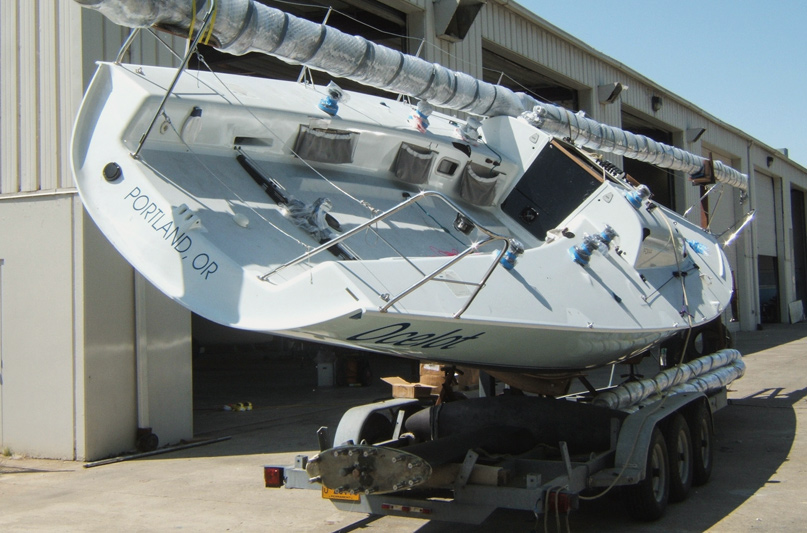
Rander eventually ended up sailing a total of 24 crossings to Hawaii, all but one in boats he built and owned, before hanging up his sail.
There was also a problem with the C2’s hull showing signs of delamination. Kevin Flanigan decided to purchase the boat and trucked it to Portland, where it was re-engineered with a double V-berth in the forepeak and additional stringers to stiffen the hull. To solve the mast issue, he re-rigged it as a conventional sloop with stays. The boat was re-launched with a new name — Ocelot — and the design was re-named the Fox 44.
“Ocelot was a great race boat. We won many races including the Windjammers to Santa Cruz in 2007. We won the Offshore Series in 2010,” he recalled. “I raced her to Puerto Vallarta in 2012, finishing third overall. I learned offshore racing and how to manage a crew. It was a life- changing experience! I donated the boat to the Skiff Sailing Foundation in 2014.”
By 2000, the multihull movement had really picked up speed and cruising catamarans were being mass-produced all over the world. However, to carry passengers in U.S. waters, a boat must be U.S.-built and USCG-inspected. Their rulebook makes 65’ the size limit before a design has to meet ship-type regulations.
Schooner Creek Boat Works got its start on big fiberglass catamarans at that time with Kai Oli Oli, a 61′ power catamaran, built for Ocean Joy Cruises of Honolulu. That was followed by Kiapa, a 52′ fast cruising yacht designed by Morelli & Melvin who were the leading racing boat designers on the West Coast.
Maui Dive Shop ordered the next boat, the spacious 65’ x 36’ Alii Nui, a modern Kurt Hughes design. The next was the Trilogy II for Trilogy Excursions of Maui—the same length but narrower and a return to the yard’s origins with its Constant Camber laminated wood construction and design from John Marples Searunner of Penobscot, Maine.
When it was launched, I asked the owners why they would use wood in the 21st century. They answered very succinctly; it was because their harbor is not well protected from the trade winds and often has a lot of swell bouncing their fleet around, and wood is still the best material to withstand constant impacts against the dock.
However, that argument doesn’t seem to have much appeal for the great majority of Hawaiian operators, who were all going to Morelli & Melvin (M&M) for their new boat designs. The next was the Holokai—a 45-foot “beach cat” that M&M designed to run directly onto the beach for passenger boarding in Waikiki, Oahu.
This model was built with the full use of the latest materials and techniques—fully vacuum-infused hull and open deck from a temporary mold. Power was from twin Honda 50-hp outboards on special retractable mounts. Sail trimming winches and deck hardware are all from Harken. The tall railings were fabricated of 316 stainless steel in Schooner Creek Boat Works’ own metal shop.
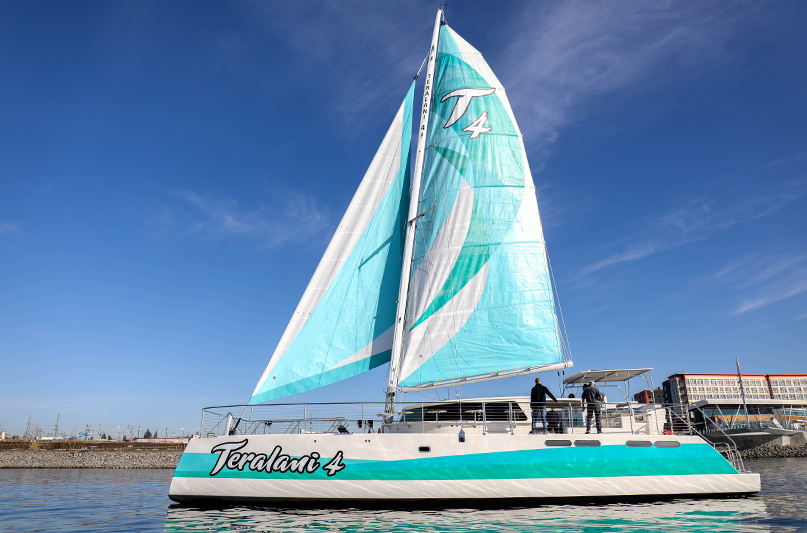
In 2015, change came once again to Schooner Creek Boat Works when long-time associates Kevin and Shauna Flanigan purchased the company from Steve and Nancy Rander.
While officially retired, Rander still does some consulting for the company. The Flanigans saw the demand for M & M designs would likely require a more durable 65’ split mold with a modern reverse bow. The standard hull speeds up the process and reduces the cost, but the deck and interior layout is still custom. This investment has paid off by encouraging more operators to consider a new state-of-the-art vessel.
The first 65’ boat from the mold was for Teralani, a charter company in Lahaina, Maui, that has been offering daytime and sunset cruises for over 25 years. The Teralani 4 was launched in January 2018 and is now at work in Hawaii.
Like other vessels in the company’s fleet, it pulls right up to the beach, so clients staying in Kaanapali can simply stroll along the sand to the loading zone, take a few steps into the ocean, and climb up the stairway lowered from the foredeck.
Compared to Teralani 2 and 3, the new vessel is distinctly different in appearance and amenities, with an attractive upscale finish in the open cabin, wrap-around seating, two spacious restrooms, and a full bar. This difference was evident at the dock in Portland even while work was ongoing for the full electric galley and entertainment system.
According to Mike Kelley, president of Teralani Sailing Adventures, “Teralani 4 has seating and individual tables for all 49 passengers, and it has a built-in barbecue grill.” Kelley continued, “It also features exclusive helm seating, which allows guests to sit comfortably on either side of the captain’s helm station, plus seating in the far rear, facing backward.” Kelley is already looking forward to the arrival of the third catamaran from the same mold, the Teralani 5.

Maui’s northwest coastline has a marine sanctuary that makes it an outstanding destination for whale-watching excursions, which are offered from mid-December to mid-April. Each year the Pacific humpback whales migrate from Alaska to the coastal waters off Maui. Being on board a spacious sailing catamaran is certainly the best way to experience these giants of the sea and the surrounding beautiful West Maui scenery. Teralani has a marine naturalist on board each trip, and underwater hydrophone that can pick up the whale songs.
The second catamaran was for O’Neill Sea Odyssey of Santa Cruz, California, founded by surf pioneer Jack O’Neill. Their boat, Team O’Neill, recently set sail to educate the public on the wonders of the ocean, specifically Monterey Bay’s National Marine Sanctuary. They wanted a new boat that could fill dual roles as an educational platform for school trips and conventional cruise provider.
Since 1996, when O’Neill started a marine education program for school kids and community groups, more than 100,000 kids have gotten onto the water thanks to the program. Jack O’Neill—who passed away on 2017 at the age of 94—called the Sea Odyssey his life’s “greatest accomplishment.”
The construction was fiberglass sandwich with a foam core in the hulls, deck, and cabin—all vinylester resin-infused. The accommodations are intended to meet the needs of both the educational children’s tours during the day for O’Neill Sea Odyssey and the evening and weekend cruises for O’Neill Yacht Charters, with a complete galley and entertainment system.
Power for propulsion is provided by twin 125 horsepower John Deere auxiliary engines, and all deck equipment is chosen for durability and ease of operation. Onboard there is a closed cabin with indoor seating, a kitchen/bar, four bathrooms, and two bedrooms. On deck there are two trampolines, access to crew quarters, and an aft salon with additional seating.
At the end of 2018, when the crew arrived to deliver the Team O’Neill to Santa Cruz, Kevin Flanigan decided to join them to really see how the new boat handled. “We had a calm delivery of Team O’Neill, motoring most of the way,” he told me. “It was a real sense of accomplishment to drive a boat we built. The owner, Tim, was happy with it too. I enjoyed the night watch knowing I was delivering my first build. Constant checks for anything going wrong or coming loose filled our time. Arriving in Santa Cruz with all systems working well was a great relief.”
Schooner Creek Boat Works is truly the little wooden boat shop who could. Personally, I have had immense satisfaction watching and reporting as Schooner Creek Boat Works has grown into one of the largest and most advanced repair, maintenance, and new construction yard on the West Coast.
Read the print version on Issuu